RBSE Solutions for Class 9 Science Chapter 8 Major Activities of Living Organisms are part of RBSE Solutions for Class 9 Science. Here we have given Rajasthan Board RBSE Class 9 Science Chapter 8 Major Activities of Living Organisms.
| Board | RBSE |
| Textbook | SIERT, Rajasthan |
| Class | Class 9 |
| Subject | Science |
| Chapter | Chapter 8 |
| Chapter Name | Major Activities of Living Organisms |
| Number of Questions Solved | 142 |
| Category | RBSE Solutions |
Rajasthan Board RBSE Class 9 Science Chapter 8 Major Activities of Living Organisms
Major Activities of Living Organisms Textbook Questions Solved
Objective Type Questions
Question 1.
The water in plants is conducted by-
(A) Phloem
(B) Xylem
(C) Sieve tubes
(D) Epidermis
Answer: B
Question 2.
The water which a plant receives from soil is-
(A) Hygroscopic water
(B) Gravitational water
(C) Guttated water
(D) Capillary water
Answer: D
Question 3.
The stomata exchange-
(A) Water vapour and gases.
(B) Oxygen and hydrogen.
(C) Oxygen and carbohydrate.
(D) Nitrogen and water vapour
Answer: A
Question 4.
The conduction of food material is by-
(A) Xylem
(B) Phloem
(C) Lenticles
(D) Epidermis
Answer: B
Question 5.
The respiratory pigment is-
(A) Reb blood corpuscles
(B) Phloem
(C) Haemoglobin
(D) Epidermis
Answer: C
Question 6.
What is a higher side blood pressure of the normal body-
(A) 120 nm
(B) 90 nm
(C) 140 nm
(D) 80 nm
Answer: A
Question 7.
Which is not a function of the stomach-
(A) Storage of food
(B) Absorption
(C) Digestion
(D) Complete digestion of fat
Answer: D
Question 8.
The main example of fission is-
(A) Spirogyra
(B) Bryophyllum
(C) Yeast
(D) Amoeba
Answer: C
Question 9.
The reproduction in Rhizopus takes place by-
(A) Binary fission
(B) Budding
(C) Spermatogenesis
(D) Multiple fission
Answer: C
Question 10.
Ovules are arranged upon-
(A) Ovary
(B) Style
(C) Anther
(D) Embryo
Answer: A
Question 11.
The metabolic process in plants is dependent on-
(A) Proteins
(B) Fats
(C) Carbohydrates
(D) Vitamins
Answer: C
Question 12.
Guard cells are found in-
(A) Root
(B) Stem
(C) Leaf
(D) Flower
Answer: C
Question 13.
Guttation is seen, when-
(A) Respiration is high
(B) High absorption and low transpiration
(C) Photosynthesis is high
(D) Diffusion is more
Answer: B
Question 14.
Ureotelic excretion is found in-
(A) Amoeba and frog
(B) Aves and Fishes
(C) Fishes and Snakes
(D) Human and frog
Answer: D
Major Activities of Living Organisms Very Short Answer Type Questions
Question 15.
What is the method of excretion in aquatic plants?
Answer
In hydrophytes (aquatic plants), waste product diffuses out from the cell membrane of the cell into the surrounding water.
Question 16.
What is the function of guard cells?
Answer
Guard cells contain chlorophyll and so, carry out photosynthesis. When guard cell swells up, stomata will open and when it contracts, stomata close.
Question 17.
What is uricotelic excretion?
Answer
Uricotelic exertion is the exertion of nitrogenous waste products, in the form of uric acid, by uricotelic animals, e.g., Birds, Lizards, Snakes.
Question 18.
Name the two main parts of a plant.
Answer
The two main parts of a plant are root and leaves.
Question 19.
From which vascular tissue, the water reaches to the leaves?
Answer
Xylem.
Question 20.
What is the function of phloem?
Answer
Phloem conducts food materials from leaves to different parts of the plant.
Question 21.
Define plasmolysis.
Answer
If a cell is placed in a solution having high concentration, then protoplasm will begin to shrink and leave the cell wall and round off. This shrinking of protoplasm is called plasmolysis.
Question 22.
What is respiration?
Answer
Respiration is a catabolic (breaking down) reaction, involving burning up of food substances, such as carbohydrates, fats and proteins, within the tissue to produce energy, stored as ATP. Respiration helps to carry O2 from lungs to the tissues for internal respiration and to bring back CO2 to the lungs.
Question 23.
What is binary fission?
Answer
Binary fission: In this methods, the parent animal gets divided into two similar animals. It is a complex process of mitotic division.
For example: Amoeba, Euglena, Paramaecium.
Question 24.
What is the floral part?
Answer
Floral part is swollen part, present on the upper side of the flower stalk.
It consists of four sets:
(1) Calyx
(2) Corolla
(3) Androecium
(4) Gynaecium.
Question 25.
Write the main example of air layering?
Answer
Air layering is mostly found in raspberries, Magndia, Jasmine, Pomegranate etc.
Question 26.
Why reproduction is necessary for animals?
Answer
The process of reproduction ensures the continuity of life on the earth. It is essential for the survival of species on the earth. Human beings produce human children, dogs give birth to puppies, cats produce kittens, hens produce chickens, a rose plant propagates rose planets, sunflower seeds always grow into a sunflower plant and so on, so that their species may continue to live on this earth. If species of living organism do not reproduce organisms of that species will gradually die and ultimately vanish from the universe. Thus, it is the process of reproduction that keeps the stability of population among species.
Major Activities of Living Organisms Short Answer Type Questions
Question 27.
Point out the differences between taproot and adventitious root?
Answer
1.Taproot: The root system formed from radicle of the seed, consisting of a distinct primary root and smaller lateral roots. It is the characteristic of dicot plants.
2. Adventitious root: These roots develop from a source other than the radicle. They arise from nodes, internode, leaves and base of the stem. They are the characteristics of monocot plants.
Question 28.
Clarify the differences between xylem and phloem?
Answer
Following are the differences between Xylem and Phloem:
| Xylem | Phloem |
| 1. This tissue conduct water and dissolved salts from soil to the different parts of the plant | 1. This tissue transports food synthesised by photosynthesis in liquid form from the leaves to different parts of the plant. |
| 2. Xylem tissue is made up of vessels and tracheids. | 2. Phloem tissue is made up of sieve tubes and companion cells. |
Question 29.
Define the following:
(1) Diffusion
(2) Osmosis
(3) Plasmolysis
(4) Imbibition.
Answer
1. Diffusion: The movement of molecules in the direction of concentration gradient i.e from a region of higher concentration to that of lower concentration is called diffusion. It occurs only when the concentration of the diffusing substances is not uniform.
2. Osmosis: It is a special form of diffusion, where two solutions of different concentrations are separated by a semipermeable membrane. In this, molecules move from a weaker solution to a stronger solution.
3. Plasmolysis: f a cell is placed in a solution having a higher concentration, then cell the water molecules will move from the cell sap to outer solution and turgidity of cell wall will go on decreasing and cell wall begin to shrink. This shrinking of protoplasm is called plasmolysis.
4. Imbibition: It is a process by which the rise of water occurs, due to the attraction between water molecules and molecules of the substance. The water absorbed by a cell wall and hard seed coat is mostly through imbibition.
Question 30.
Explain the theory pertaining to the ascent of water from root to leaves?
Answer
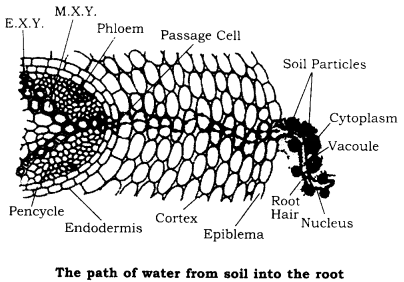
Between the spaces in the soil particles, are present air and water. This water is in the form of thin film around the soil particles. This is called capillary water. The roots of plants absorb this water. Water is mainly absorbed by the root hair zone of roots. Mineral salts remain dissolved in the capillary water of soil and so it is a type of dilute solution. The cell sap of the root hair is more concentrated than the solution in the soil. In the diagram, the arrows indicate the direction of movement of water. So, the water of the soil enters the root hair by osmosis. As a result, cell sap of root hair becomes less diluted than the cell sap of the adjacent cell and the solution moves to the next cell by osmosis. Thus, an osmotic pressure gradient is created, from xylem vessels to cortical cells of root hairs. Due to this gradient, water and mineral sap continuously move from root hair to the xylem tissues of roots and to the leaves through xylem tissue.
Question 31.
Describe the functions of the stomach?
Answer
The wall of the stomach has gastric glands which secrete gastric juice. This gastric juice contains- mucus, hydrochloric acid and protease or protein-digesting enzyme, pepsin.
Role of Hydrochloric Acid:
- It makes the medium of gastric juice acidic so that the enzyme pepsin can digest the food properly. Pepsin can work only in an acidic medium if acidic pH is not provided, then the pepsin remains inactive.
- It kills any bacteria which may enter into the stomach with food.
Role of Mucus:
- Mucus forms a protective lining on the inner wall of the stomach. It means it protects the wall of the stomach from the corrosive effect of hydrochloric acid and proteolytic nature of pepsin. The wall of the stomach is also made of proteins, but it is not digested by pepsin because pepsin is screted in an inactive form. It becomes active in the presence of HC1, secreted when there is food in the stomach. When there is no food, there is no secretion of pepsin and secondly, there is a protective coating of mucus over the stomach wall.
- Mucus lubricates the food and gives it semi-solid texture.
- Role of Pepsin: Pepsin acts on proteins and converts them into simpler peptide molecules.
Question 32.
How many types of circulatory systems are found in animals?
Answer
There are two types of circulatory system, found in animals. They are:
Open type circulation:
- In this blood spreads out through large open spaces called sinuses, within the tissues of the body.
- Body tissues are in direct contact with blood.
- The volume of blood flowing in tissues cannot be regulated.
- There is no heart.
For example Insects like grasshopper, cockroach etc.
Closed type Circulation:
- The circulatory blood remains confined within the blood vessels at all times. It does not spread in open spaces.
- Body tissues are not in direct contact with blood.
- The volume of blood flowing through tissue or organ can be controlled by contraction and relaxation of muscles of arteries.
- The heart is present, which works like a pumping station.
For example Earthworm, Man (Human beings)
Question 33.
What are catabolic and anabolic processes?
Answer
Catabolic Processes: In catabolic processes, complex compounds are disintegrated whereby simple compounds are produced. The energy produced during these processes is utilised in the accomplishment of various biological processes.
Anabolic processes: In anabolic processes, complex compounds are produced by the fusion or reaction of simple compounds. These complex compounds are essential for the organisation and formation of various structures of cells.
Question 34.
Why specific excretory organs are not found in plants? Explain.
Answer
The process of excretion in plants is quite simple. Hence, excretory organs are not found in plants.
Some reasons are as follows:
- The rate of catabolism in plants is much lower than animals. As a result, the metabolic waste accumulates in the plant body at a much slower rate.
- Green plants use much of the wastes of catabolism in their anabolic processes. For example, water and carbon dioxide produced in respiration is used in photosynthesis. The nitrogen waste produces serious problems in animals. In plants, nitrogen compounds can be used again, in protein synthesis.
- Metabolism in animals is based largely on proteins, while in plants it is based on carbohydrates. Such metabolism reduces the excretory needs because waste products of carbohydrate metabolism are less poisonous as compared to the nitrogenous waste of protein metabolism.
- Inland plants, carbon dioxide, oxygen and water vapour (these are waste products in plants) are given out through stomata or lenticles.
Question 35.
What is budding?
Answer
Budding is an asexual method of reproduction. In this, a bulb-like projection (bud) is formed on one side of the parent organism, which then detaches and becomes a new organism.
Question 36.
What is reflex action? Give some examples.
Answer
Reflex action is an automatic response to a stimulus which is not under conscious control, e.g., sneezing, blinking of eyes, coughing, etc.
Major Activities of Living Organisms Long Answer Type Questions
Question 37.
What is guttation? Explain with examples.
Answer
Guttation: The exudation of water from plants in a liquid form, by leaves is known as guttation. It takes place when environmental conditions are favourable, so, as to check transpiration, the air is very humid.
Sometimes, water oozes out of the margin of leaves of peepal, tomato, Nasturtium, lawn grass in the morning hours and in the night in the form of minute drops. This is called guttation.
In plants which show guttation, there are special stomata, the water stomata or hydathodes located on margin and the apex of leaves, just next to the vein ending. They open internally into a small cavity surrounded by thin-walled parenchyma.
Conditions for guttation:
- Guttation increases when absorption rate is more than the rate of transpiration.
- When there is enough humidity in the atmosphere, then guttation is more.
Question 38.
Explain the Internal structure of the leaf?
Answer
The internal structure of the leaf
The leaf consists of three main portions:
(a) Upper Epidermis
(b) Lower Epidermis
(c) Mesophyll, and
(d) Vascular bundles.
In the leaf, the cuticle layer of wax and skinny part called the epidermis, are the outermost part. It consists of a single layer of parenchymatous cells. Upper epidermis is protected by non-cellular substance, cutin and lower epidermis are interrupted by stomata, bounded by kidney-shaped guard cells.
Mesophyll: It is differentiated into-
(1) Palisade, and
(2) Spongy parenchyma.
The palisade parenchyma lies just below the epidermis and spongy parenchyma lies below the palisade parenchyma. This region is found between the upper and lower epidermis. Photosynthesis occurs in the palisade cells of mesophyll tissue and water is transported through the vascular bundle existing in the leaf vein.
The chloroplasts are more abundant in palisade cells than in spongy cells, therefore, the upper surface of a leaf appears darker than the lower surface. Large intercellular spaces in spongy parenchyma allow free circulation of gases, throughout the leaf. Vascular bundles: Running through the mesophyll are the veins. Each vein represents a vascular bundle, formed of phloem and xylem. Phloem lies towards the upper epidermis, while xylem lies towards the lower epidermis. Each vascular bundle is surrounded by a colourless parenchymatous bundle sheath
Question 39.
Explain root pressure in plants with the help of an experiment.
Answer
Water from soil reaches xylem vessels of the root, because of osmotic pressure gradient and from there it rises up due to pressure. The pressure which causes water to rise up in xylem is called root pressure. It is a vital pressure which pushes water upwards. This is possible when cortical cells alternately pulsate. This root pressure can be understood through a simple experiment.
Experiment: Take a well-watered potted plant and cut the main stem to 7cm above the soil surface and join the cut end of the stem with a glass tube, with the help of a rubber tube joint. Fill some water in a glass tube up to the fixed mark.
Make the rubber joint airtight, by applying molten wax, grease or vaseline. Keep the apparatus for an hour or so. It will be observed that water in glass tube is rising. The rise in a glass tube is due to root pressure, which pushes up the water from root to stem. The magnitude of root pressure is not much.
Question 40.
Describe respiration in human beings with a labelled diagram?
Answer
The respiratory organs of a man is a lung. Some accessory respiratory organs are
1. Nose
2. Pharynx
3. Trachea.
1. Nose: It’s outermost opening, having a pair of external nares (nostrils) followed by a ridge, the nose. Air enters through nostrils. The nostrils contain hair which helps in filtering out the dirt of air. Other foreign particles i.e. germs may lodge on the moist mucous membrane of the nasal passage. The nasal passage leads internally through the internal nares into the pharynx.
2. Pharynx: From the nasal passage air enters the throat through the pharynx. Pharynx contains the openings of windpipe (trachea) called glottis and of food passage (oesophagus) called gullet. Between these two openings, there is a cartilaginous flap, the epiglottis which normally covers the gullet, except when something is swallowed; when it covers the glottis, so that chewed food only enters in the food pipe.
3. Trachea: The trachea is a pipe like structure, which is as long as the neck of the man. Trachea is covered by a semi-circular ring like cartilage on its sides and front. At its upper part is Larynx, the sound box. In the region of the chest, trachea bifurcates into bronchii. Each bronchus enters into the lung of the same side and there, it further divides into many branches-the bronchioles and fine capillaries each entering into air-sacs.
Main respiratory organ: Lungs:
Lungs are two in number. These are enclosed in chest box. Each lung has a double wall of pleural membrane. The outer pleural membrane is in contact with muscles of ribs. Each lung is a spongy bag-like structure.
The inner pleural membrane is raised into a large number of sacs, the air sacs which increase the area for exchange of gases. These air sacs, are richly supplied with blood vessels.
Each air sac looks like a cluster of a number of grapes and consists of a number of balloon-like swelling, called alveoli. These alveoli are thin, moist membranes and one cell thick layers. They are in close contact with the extensive capillary network. They act as a functional unit of lungs, in which the exchange of gases takes place.
Question 41.
Explain the method of Grafting?
Answer
Grafting: In this method of reproduction, two plants of closely related varieties are joined together, so that they live as one plant. The plant, whose roots remain in the soil is called as stock and the one of which small shoot is to be used is called Scion. Cambium of both stock and scion are fused to form a connection between the two. This fusion can be done in various ways. Accordingly, grafting is classified into three types:
(A) Whip or tongue grafting: In this type, stock and Scion, which are of the same diameter are given oblique cuts, so that scion closely fits over the stock. They are tied by moist clay.
(B) Wedge grafting: In this type of grafting, wedge-shaped or V-shaped cut is given in the stock. In the scion, a vertical slit is formed, so that it can be inserted into the stock. Then Scion and stock are tied by the moist clay, as in tongue grafting.
(C) Crown grafting: If the diameter of the stock is more than that of the scion, then more than one scions can be grafted on a single stock. Scion is cut into long wedges on the lower end. These cuts should match with those present in the stock. Later on, these are tied together firmly.
(D) Bud grafting: In this type of grafting, a bud along with some portion of the living tissue is taken as a scion. T-shaped cut is made in the bark of the stock. Scion is then inserted into this T-shaped cut. Both are then tied together, with strings and not allowed to dry. After a few days, bud becomes part of the stock plant and starts germinating.
Question 42.
Describe double fertilisation?
Answer
Involves the fusion of male and female gametes (syngamy) and fusion of male gamete with a secondary nucleus (triple fusion)
After discharge from the pollen tube, one of the male gametes fuses with the egg and forms the oospore (zygote). This is called true fertilisation (also called syngamy = amphimixis). The oospore is diploid (2n).
The second male gamete fuses with the secondary nucleus (2n) and forms a triploid (3n) nucleus, called the endosperm mother nucleus. This is called triple fusion. Thus both the male gametes participate in fertilisation, i.e., fertilisation takes place twice.
This is called double fertilisation. (Double fertilisation includes syngamy as well as triple fusion), zygote produced, as a result of syngamy develops into an embryo and the triploid nucleus (= Endosperm mother nucleus), develops into the endosperm which is used for nutrition of embryo. Antipodals and synergids degenerate after fertilisation.
Question 43.
Briefly explain pollination?
Answer
Pollination is the process of transfer of pollen grains from the anther and their deposition on to the stigmatic surface of the flower.
It is mainly of two types:
(a) Self Pollination
(b) Cross-Pollination
(a) Self-pollination is between the flowers of the same plant. It is of two types: autogamy, in same flower and geitonogamy, in the different flower of the same plant.
(b) Cross-pollination is between the flowers of different plants.
It takes place in various ways:
- Wind Pollination – Anemophily
- Insect Pollination – Entomophily
- Water Pollination – Hydrophily
- Bird Pollination – Ornithophily
- Bat Pollination – Chiropterophily
Question 44.
Describe the reproductive organs of a human with the help of a labelled diagram?
Answer
The male reproductive system consists of the following organs:
1. Testes,
2. Vas deferens,
3. Seminal vesicle,
4. Urethra.
1. Testes: The male reproductive organs consist of two tests, lying in a special pouch of skin called scrotum sac, outside the body between the two legs. They are specialised for the production of spermatozoa. Each testis is made of the number of coiled tubes called seminiferous
opens in the collecting duct, called epididymus. The sperms are produced by cells of epithelium layer of the seminiferous tubules and are stored in the epididymus. Each sperm consists of three parts- the anterior end of sperm is called ahead. The nucleus containing chromosomes is located in the head. Behind the head is the middle portion. The third part is the tail, which helps in its movement.
2. Vas deferens: From each epididymis arises a duct called vas deferens, which opens in the broad structure called seminal vesicles.
3. Seminal vesicle: It is situated on the anterior part of the urethra. From seminal vesicle arises a tube called ejaculatory duct. Before ejection, the sperms are stored in this duct.
4. Urethra: The ejaculatory duct opens in a duct called urethra, which passes through a long and muscular path, present in the penis. This long path opens outside the body through a small opening. The urine and sperms pass out through this opening hence, it is called urino-genital aperture.
The female reproductive organs are as follows:
(1) a pair of ovaries
(2) a pair of oviducts or fallopian tubes
(3) Uterus
1. Ovaries: The female reproductive system consists of two ovaries, located in abdominal cavity, just below the kidney. The ovaries are white or cream coloured. They are of oval shape. The inner layer is made up of germinal epithelium cells, which by the process of oogenesis produces eggs. In front of each, there is a funnel-shaped structure called ostium.
2. Oviducts or Fallopian tubes: The posterior end of the ostium is in the form of a duct called oviduct. The Female reproductive organs walls of the ovary are muscular and made up of ciliated epithelium. The action of cilia and the peristaltic act of the duct walls, help the egg to move towards the uterus.
3. Uterus: The posterior part of the oviduct opens into hollow sac-like structure called uterus. The walls of the uterus expand according to need, during the development of embiyo. The anterior tubular part of uterus is called vagina and posterior part is called vulva.
Major Activities of Living Organisms Additional Questions Solved
Multiple Choice Questions (MCQs)
Question 1.
The gas liberated (given out) in photosynthesis is-
(A) Carbon dioxide gas
(B) Oxygen gas
(C) Nitrogen gas
(D) Hydrogen gas
Answer: B
Question 2.
Examples of chemosynthetic organisms are-
(A) Sulphur bacteria and Ficus
(B) Copper bacteria and Ficus
(C) Margosa bacteria and Ficus
(D) Sulphur and copper bacteria
Answer: D
Question 3.
Dark reaction in photosynthesis is called because-
(A) it does not require light energy
(B) it also occurs in darkness
(C) it occurs more rapidly at night
(D) it cannot occur during day time
Answer: A
Question 4.
The animals that depend on the blood of other animals, for their food are called-
(A) Herbivores
(B) Carnivores
(C) Sanguivorous
(D) Omnivorous
Answer: C
Question 5.
The acidic food coming from the stomach is neutralised in the small intestine by-
(A) Saliva
(B) Trypsin
(C) Lipase
(D) Bile
Answer: D
Question 6.
Digestion is extracellular in-
(A) Animals like human
(B) Amoeba
(C) Fungi
(D) Both A and C
Answer: D
Question 7.
The exchange of gases occurs in human beings takes place in-
(A) Skin
(B) Mouth
(C) Nose
(D) Lungs
Answer: D
Question 8.
The rings in trachea are-
(A) 16 – 20
(B) 18 – 22
(C) 20 – 24
(D) 22 – 26
Answer: A
Question 9.
In anaerobic respiration is produced.
(A) Pyruvic Acid
(B) Lactic Acid
(D) Citric Acid
(D) Malic Acid
Answer: B
Question 10.
In normal expiration the diaphragm is-
(A) Arched
(B) Flattened
(C) Not involved
(D) Perforated
Answer: A
Question 11.
The trachea is prevented from collapsing by-
(A) Complete cartilaginous rings
(B) incomplete cartilaginous ring
(C) bony rings
(D) Chitinous rings
Answer: B
Question 12.
The circulatory system of cockroach is-
(A) Closed type
(B) Open type
(C) Both type
(D) By diffusion
Answer: B
Question 13.
Which of the following return blood from various body tissues to the heart-
(A) Veins
(B) Arteries
(C) Venules
(D) None of these
Answer: A
Question 14.
Our body temperature is regulated by-
(A) Blood
(B) Veins
(C) Arteries
(D) Capillaries
Answer: A
Question 15.
The flow of water from a cell to outside in more concentrated solution results in shrinking and rounding of protoplasm, this is due to-
(A) Absorption
(B) Plasmolysis
(C) Imbibition
(D) Exosmosis
Answer: B
Question 16.
The process of transpiration in plants help in-
(A) opening of stomata
(B) absorption of CO2
(C) upward conduction of water and mineral
(D) absorption of O2
Answer: C
Question 17.
Malpighian tubules are found in-
(A) Amoeba
(B) Earthworm
(C) Hydra
(D) Cockroach
Answer: D
Question 18.
On the basis of excretion, which of the following group is uricotelic-
(A) Lizard and Hydra
(B) Lizard and Amoeba
(C) Lizard and Bird
(D) Lizard and Fish
Answer: C
Question 19.
Which of the following nitrogenous waste product is excreted by Hydra-
(A) Ammonia
(B) Urea
(C) Uric acid
(D) All the above
Answer: A
Question 20.
Excretion of nitrogenous wastes mainly as uric acid by birds is helpful for-
(A) Conserving body water
(B) Eliminating excess body water
(C) Eliminating excess body heat
(D) Conserving body heat
Answer: A
Question 21.
In comparision to animals, the rate of excretion in plants is-
(A) more
(B) less
(C) equal
(D) absent
Answer: B
Question 22.
Hydathodes found in plants are meant for the escape of –
(A) Carbon dioxide
(B) Oxygen
(C) Urea
(D) Water.
Answer: D
Question 23.
Metabolism of which group of organic compound produces more harmful waste products-
(A) Fats
(B) Starch
(C) Proteins
(D) Sugar
Answer: C
Question 24.
By which method asexual reproduction occurs in amoeba-
(A) Fission
(B) Budding
(C) Germination
(D) All of these
Answer: A
Question 25.
Rupturing of ovarian follicle and discharge of ovum is known as-
(A) Copulation
(B) Ovulation
(C) Conjugation
(D) Oviposition
Answer: B
Question 26.
Menstruation in human females stops after the age of about-
(A) 65
(B) 60
(C) 45
(D) 35
Answer: C
Question 27.
The largest part of the brain is-
(A) Cerebrum
(B) Cerebellum
(C) Spinal cord
(D) Medulla oblongata
Answer: A
Question 28.
The cerebellum is concerned with-
(A) Coordination and muscular movements
(B) Perception
(C) Memory
(D) Vision
Answer: A
Question 29.
Endocrine glands are those which put their secretions into-
(A) Ducts
(B) Blood
(C) Both
(D) None of the above
Answer: B
Question 30.
Reflex action is controlled by-
(A) Spinal cord
(B) Peripheral Nervous System
(C) Autonomous Nervous System
(D) Brain
Answer: A
Major Activities of Living Organisms Very Short Answer Type Questions
Question 1.
Define Nutrition?
Answer
Nutrition is the whole process by which an organism obtains its food.
Question 2.
What are chemotrophs?
Answer
Chemotrophs are the organism, which manufactures their food from in organic substance in the presence of energy derived from inorganic compounds.
Question 3.
Differentiate between: autotrophs and heterotrophs.
Answer
Autotrophs are green plants who manufacture their own food with the help of H2O,CO2 and sunlight. Heterotrophs are animals who depend upon autotrophs and are not capable to synthesise their own food.
Question 4.
What are Nutrients?
Answer
All those food substances from which organisms get energy, and are able to synthesise cellular substances are called nutrients.
Question 5.
What are finger-like projections of the intestinal wall called?
Answer
Villi.
Question 6.
For what purpose, energy is required by a living organism?
AAnswer
Energy is required to perform life processes, which maintain the internal organisation of living organisms.
Question 7.
What is the importance of air sacs?
Answer
Air sacs are the functional units of lungs, which increase the area for exchange of gases.
Question 8.
Which type of process is respiration?
Answer
Respiration is a catabolic process.
Question 9.
What is epiglottis?
Answer
At the mouth of the glottis is a cartilagenous flap called epiglottis. It prevents the entry of food in the windpipe and thus, facilities breathing process to go on smoothly.
Question 10.
By which mechanism, heart beat is controlled?
Answer
Heartbeat is controlled by chemical impulsion and signals of nerves
Question 11.
Write any two functions of blood.
Answer
(1) It carries oxygen to the cells.
(2) It forms clots to plug leaking vessels, to stop bleeding.
Question 12.
Define heart-beat.
Answer
One complete contraction and relaxation of the heart is called a heartbeat.
Question 13.
What is normal blood pressure?
Answer
It is the systemic arterial blood pressure, which the blood flowing through the arteries exerts on their walls.
Question 14.
What are capillaries?
Answer
The capillaries are thin walled and extremely narrow tubes or blood vessels, which connect arteries to veins.
Question 15.
What is lymph?
Answer
Lymph is a pale yellow fluid derived from the blood plasma, containing water with dissolved proteins inorganic salts, food materials, waste product and a varying number of WBC’s mostly lymphocytes.
Question 16.
What is transpiration?
Answer
Loss of water in the form of water vapours through stomata, is called transpiration.
Question 17.
Explain the term ascent of sap?
Answer
The upward movement of water and minerals from the root towards the top of the plant, is known as the ascent of sap.
Question 18.
What is osmosis?
Answer
Osmosis is the flow of water molecules from a region of higher water potential, to a region of lower water potential through a semi-permeable membrane.
Question 19.
What is the function of the root cap?
Answer
Root cap protects the delicate growing region of root from injury, caused by scraping against the soil particles.
Question 20.
Give two functions of contractile vacuoles of an amoeba?
Answer
1. Osmoregulation,
2. Releasing waste water on bursting.
Question 21.
What are sweat glands?
Answer
Sweat glands are small coiled tubular glands whose duct leads to the surface of the skin.
Question 22.
Define metabolic waste.
Answer
Metabolic wastes are those products which are produced in metabolic reactions, and not useful to the organism.
Question 23.
Why is excretion process more simple in plants than animals? Give one reason.
Answer
In plants, metabolism is mostly anabolic in nature. The rate of catabolism is much slower than in animals. Therefore, the rate of accumulation of metabolic wastes is also slower.
Question 24.
What is the female reproductive hormone?
Answer
In females the ovary secretes two hormones, called female reproduce hormones;
(a) Estrogen,
(b) Progesterone.
Estrogen was secreted before ovulation and progesterone were secreted to prepare the uterus for receiving the embryo.
Question 25.
What is the period of heat? (Oestrous cycle)
Answer
During this cycle, a desire for reproduction increases tremendously in females, after ovulation. This cycle is found mostly in mammals.
Question 26.
Write two functions of flower relating to reproduction.
Answer
Two functions of flowers related to reproduction are as follows:
- To produce male and female gametes, after developing male and female gametophytes in reproductive organs, respectively.
- To accomplish the fusion of male and female gametes or fertilisation.
Question 27.
Name the hormone secreted by thyroid gland?
Answer
The thyroid gland produces two hormones,
(a) thyroxine,
(b) tri-iodothyronine.
Question 28.
Name three parts of the nervous system of an earthworm.
Answer
1. Central nervous system,
2. Peripheral nervous system,
3. Autonomous nervous system
Question 29.
Which endocrine gland is called master gland?
Answer
The pituitary gland is called master gland because it controls the secretions of other endocrine glands.
Question 30.
What is reflex action?
Answer
Reflex action is an automatic response to a stimulus, which is not under conscious control. For example, sneezing, blinking of eyes, coughing, etc.
Major Activities of Living Organisms Short Answer Type Questions
Question 1.
Describe the pigments which are essential in photosynthesis?
Answer
Mainly three types of pigments are found in plants, namely, chlorophyll, carotenoids and phycobilins. All three pigments are found in chloroplasts. These pigments trap the light energy. Other pigments found in plastids are called chromoplastids. Photosynthesis takes place only in chloroplast. Hence, the pigment outside it such as anthocyanons, yellow xanthophyll and red-orange coloured carotenoids, do not take part in photosynthesis. But carotenoids and phycobilins present in chloroplasts, helping in photosynthesis, indirectly. These absorb light energy and transfer to chlorophyll pigment.
Question 2.
What is respiration?
Answer
Respiration is a catabolic (breaking down) reaction, involving burning up of food substances such as carbohydrates, fats, proteins within the tissue to produce energy stored, as ATP. Respiration help to carry O2 from lungs to the tissues for internal respiration and to bring back CO2 to the lungs.
Question 3.
Give two dissimilarities and similarities between respiration and combustion?
Answer
Dissimilarities between Respiration and Combustion.
| Respiration | Combustion |
| 1. Respiration is controlled by different enzymes. | 1. There is no control in combustion. |
| 2. Energy is released step by step, at normal (body) temperature. | 2. Most of the energy is released suddenly, in the form of heat and light. |
Similarities between respiration and combustion: In both, substances consumed are organic compounds and energy is released. Both these processes require oxygen, carbon dioxide and water are formed in both the process.
Question 4.
Clarify the difference between the two types of Respiration?
Answer
| Aerobic respiration | Anaerobic respiration |
| 1. Oxygen is needed in aerobic respiration | 1. Oxygen is not needed in anaerobic respiration. |
| 2. Here, complete oxidation of glucose takes place. | 2. In anaerobic respiration, the glucose molecule is incompletely broken down. |
| 3. End products of aerobic respiration are; COa, water and energy; C6H12O2 + 6O2→ 6H20 + 6 CO2+ 686 kcal energy |
3. End products of anaerobic respiration are ethyl alcohol, carbon dioxide. 50 kcals energy is given off. C6H12O2→ 2C2H5OH+ 2CO2+ 50 kcal Energy. |
| 4. 38 ATP molecules are formed. | 4. Only two molecules of ATP are formed. |
| 5. Respiratory material is completely oxidised. | 5. Respiratory material is not completely oxidised. |
| 6. It is a normal method of respiration and occurs in all living cells. | 6. It is present only in few organisms sand in others, it occurs for short duration in like fungi, bacteria, etc. |
Question 5.
What are characteristics of circulation in earthworm?
Answer
Circulation in earthworm: There is a closed circulatory system in the earthworm. The earthworm has two main dorsal and ventral vessels. At the anterior end of these two vessels, are four pairs of heart. By the pulsation of the heart, the blood flows and circulates in the body through the ventral vessel. After circulation in the body, the blood reaches the heart through dorsal vessel. The rhythmic contraction of heart pumps the blood into ventral vessels. The blood after circulation returns to the heart, by dorsal vessel valves in the heart. Dorsal vessel is like a one-way door, which keeps the blood flowing in the right direction. Earthworm blood contains red, an ionised pigment called haemoglobin, for the transportation of oxygen. Haemoglobin is found in a plasma fluid. Thus, in the earthworm, the transportation of oxygen and mechanism of respiration is less efficient as compared to man.
Question 6.
How does circulation in the cockroach? occur? Explain.
Answer
Circulation in the cockroach: In cockroach, nutrients and waste products are transported by the open circulatory system. In cockroach, there is a main dorsal vessel termed as heart or aorta. It is a muscular tube, which has 13 chambers. The heart is pulsating. In it, blood flows from the posterior portion to the anterior portion. Heart or aorta opens at the apex of the anterior portion The blood in an anterior part of the body, leaves the aorta and spread through large open spaces in the body called sinuses. The blood now, trickles backwards through the sinuses and reaches all cells. Finally, blood returns to the aorta, through a valve-like opening in the heart. Thus, the blood circulation is completed. Blood has no pigment, so it is not helpful in exchange of gases. For the exchange of gases, there is a tracheal system.
Question 7.
Define vessels present in a human being.
Answer
There are three types of blood vessels found in human being namely,
1. Arteries,
2. Capillaries,
3. Veins.
1. Arteries: Arteries are the thick-walled blood vessels, which carry blood from the heart to all the parts of the body. The main artery carries oxygenated blood from the left ventricle to all the parts of the body. Only the pulmonary artery carries deoxygenated blood from right ventricle to lungs.
2. Capillaries: Capillaries are thin walled and extremely narrow tubes, which connect arteries to veins. Arteries branch our into thinner tubes called arterioles, which divide further into even thinner tubes called capillaries. The capillaries join to form venules and finally to form veins.
3. Veins: Veins are thin-walled blood vessels which carry blood from all the parts of the body back to the heart. Veins return blood from the tissues to the heart. Large veins have valves to maintain this unidirectional flow. These valves open by the pressure of the blood in the direction of the flow. If the flow of the blood is in opposite direction, these valves get close, so the blood from the veins cannot go back to arteries.
Question 8.
Describe the structure and function of sieve tubes.
Answer
Sieve tubes: Sieve elements join end to end and form long sieve tubes. Sieve elements are long thin-walled living cells, having minute pores on the transverse wall forming a sieve plate. The cytoplasmic strands running through pores connect with the other cell. The mature sieve tube does not have a nucleus. Companion cells are found associated with the sieve elements. The nucleus of the companion cell controls the function of sieve tubes. The function of sieve tube is conduction of prepared food in solution from leaves to other parts of plants.
Question 9.
Explain plasmolysis in a plant cell. Draw a diagram showing stages in plasmolysis.
Answer
Plasmolysis: If a cell is placed in a solution having a higher concentration than the concentration of cell sap inside the cell, then by exosmosis cell sap will begin to come in external solution and cell begins to lose its turgidity and begin to shrink. In the end, the protoplasm will shrink and leave this wall and round off. This shrinking of protoplasm is called plasmolysis.
- Normal cell
- Contraction of vacuole
- Construction of plasm membrane
- Shunken round of cell.
Question 10.
How does excretion occur in earthworm?
Answer
Excretion in Earthworm: The excretory organs of earthworm consist of a large number of small glandular and sequentially arranged tubules called Nephridia. These nephridia are located in the body.
Each nephridium has a coiled excretory duct, which represents a simple excretory organ. The walls of these nephridia are glandular and richly supplied with blood vessels. The body cavity has a fluid, in which many waste products like ammonia and urea collect. These nephridia collect the waste products from the body cavity. The ciliary and muscular activity pushes the waste materials in the excretory tubules, from where it passes out of the body, through the outer pore. The earthworm has a circulatory7 system which carries blood to the body surface and is the main route for the removal of carbon dioxide, which is diffused out through the surface cells.
Question 11.
What is the role of Malphigian tubules in cockroach?
Answer
Role of Malphigian tubules: The excretory organ consists of 8090 yellow, glandular and tubular excretory tubules called malphigian tubules. One end of these tubules lies freely in the body cavity, while the other end opens into the alimentary canal called proctodium The malpighian tubules collect the excretory wastes from the body fluids by diffusion and pass them into the alimentary canal.The undigested food (faeces) also pass out of the body through the anus.
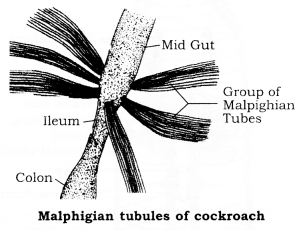
Question 12.
Explain the method of excretion in Amoeba.
Answer
Amoeba is an example of the protozoan. In unicellular amoeba, there are no special excretory organs. The carbon dioxide and ammonia formed in metabolism diffuse out of the cell body through the cell membrane (Plasmalemma).
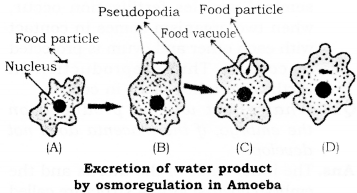
The contractile vacuole appears near the nucleus and in this water, waste products collect. The contractile vacuole goes on increasing in size and moves to the surface of the cell and it bursts open, releasing waste into the surrounding water, in which organism lives.
Question 13.
Describe the mechanism of excretion in Hydra.
Answer
Excretion in Hydra: Hydra does not have a definite specialised structure. The body of hydra is made up of two layers of cells. Carbon dioxide and ammonia are produced and passes out of the body directly by the process of diffusion. Waste matter left out after the digestion of food is thrown out of the body through its mouth, which performs the function of the mouth as well as the anus.
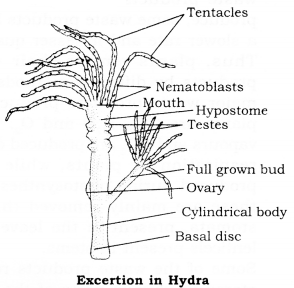
Question 14.
What is Hydathode? Explain with a diagram?
Answer
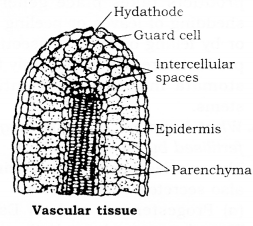
Hydathodes are specific water pores found in plants. Hydathodes are present at the terminating ends of veins on leaf margins. The water pores open in a minute cavity, which is surrounded by delicate parenchymatous cells.
Question 15.
What are excretory products of the plant?
Answer
Excretory products and their removal in plants: Unlike animals, plants do not have any definite excretory system for the removal of waste products. Plants, of course, produce, some waste products but at a slower rate and in lesser quantity. Thus, plants remove their waste products through different methods. The major waste products produced by plants are CO2, H2O and O2. Water vapours and CO, are produced during respiration by plants, while O, is produced during photosynthesis. All these are mainly removed through stomata, present in the leaves and lenticels present in stems.
Some of the waste products remain stored in various parts of the body. This waste produces are raphides (calcium-carbonate crystals), natural rubber, gums, resins, etc.
- solid waste products in plants are raphides and rubber,
- liquid waste products are essential oils (e.g. sandalwood oil, clove oil), and
- gaseous waste products are CO2 and O2.
Removal of solid and liquid waste products takes place generally by shedding of leaves or peeling of bark or by the felling of fruits. Gaseous waste products are removed mainly through stomata in leaves and lenticels in stems.
Question 16.
What happens, if ovum (egg) is not fertilised by the sperms?
Answer
The ovaries besides producing eggs also secrete two hormones:
(a) Progesterone, and
(b) Estrogen.
These hormones help in the secretion of corpusluteum. If the egg is not fertilised, then corpusluteum of ovary degenerates. Periodically, the quantity of progesterone hormone decreases in the blood, resulting in the bursting of blood vessels and the blood along with uterine fluid comes out. This is called menstruation. This process goes on in a cyclic manner, after every 28 days. It is called the menstrual cycle.
Question 17.
Explain reproduction in earthworm? diagram?
Answer
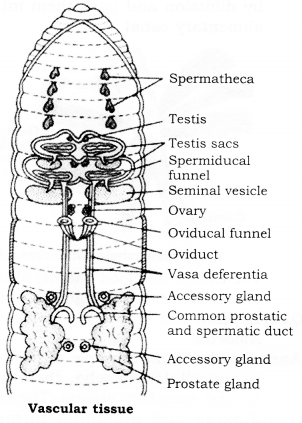
Earthworm, an animal of phylum Annelida, possesses both male and female sex organs on the same individual and thus is hermaphrodite. The female genital pore is located ventrolaterally upon its 18th segment. The same organism produces ova at one time and sperms at another time. The male genital pore is located at 11th segment. In the female reproductive organ, consisting ovary, oviduct and seminal vesicles fertilisation occur, when two organism comes in contact with each other and ovum is protected in a cocoon. Thus, reproduction in earthworm takes place in cocoons.
Question 18.
What effect will be produced on the embryo, if the placenta does not develop?
Answer
The inner walls of the uterus and the embryo (foetus) form a structure called placenta. Respiration, nutrition and excretory processes are all controlled by the placenta. If the placenta is made inactive, then the foetus will not be able to perform respiration, nutrition and excretion. As a result of which it is possible that foetus may die in the uterus.
Question 19.
Describe the structure of medulla oblongata.
Answer
Medulla oblongata: It forms the connecting limb for the forebrain and the hindbrain. It extends from the pons to the lower surface of the cerebrum. It is more or less triangular and continued behind as a spinal cord. It is hollow from inside, enclosing the fourth ventricle.
Functions: It controls involuntary actions, like coughing, sneezing, vomiting, urinating and defecating. It also controls the rate of heartbeat, breathing movement and blood pressure, by controlling the contraction and relaxation of blood vessels.
Question 20.
Explain the structure of male reproductive gland?
Answer
Testes, present only in males and located in a scrotum sac between two thighs, produce the male sex hormone called testosterone. It controls the development of secondary sexual characters in male, such as
(1) deeping of voice
(2) the growth of hair on the face (beard and moustaches), armpits and around the genital organs
(3) enlargement of genital organs size
(4) the shaping of the male body, with general angular contours, typical of adults.
Question 21.
Explain the structure of female reproductive gland and name the hormones secreted by them?
Answer
Ovaries are found only in females and located in the abdominal region of the female body.
They secrete three hormones namely:
(1) Oestrogen: FSH, from the anterior pituitary, controls the secretion of oestrogen by acting on the Graafian follicles. This hormone effects the development of female secondary sex characters. The oestrogen secretion influences the follicular phase. Its secretion is maximum during the ovulation period. Moreover, during pregnancy, the oestrogen secretion by placenta keeps on increasing till full term.
(b) Progesterone: It is secreted by corpus luteum. This hormone in contrast to oestrogen, which is producted continuously during the reproductive years, secreted only after ovulation. Progesterone prepares the uterus for receiving the embiyo. It prepares the inner lining of the uterus. This hormone is essential for the maintenance of pregnancy and is therefore called pregnancy hormone. If pregnancy does not follow ovulation, corpus luteum degenerates and breaks down for lack of progesterone.
(c) Relaxin: This hormone is secreted during later stages of pregnancy and leads to relaxation of muscles of the pelvic area, so as to enable easy childbirth end no pressure on the foetus.
Question 22.
Write a note on-Application of hormones in Agriculture?
Answer
Application of hormones in Agriculture:
- Auxin helps in rooting of cuttings and check abscission. It promotes the growth of the root, at very low concentration and shoots at higher concentration.
- It helps in the production of parthenocarpic fruits. It is observed that after pollination, the auxin content of ovary which forms the fruit is sharply increased.
- An application of auxin causes the formation of seedless or parthenocarpic fruit like grape, papaya, banana, orange and tomato.
- Gibberellin helps in breaking dormancy of seeds, buds and tubers. It also helps in seed germination, e.g., lettuce, cereals, etc.
- In cold storage, Nepthalin. Acetic Acid is sprayed on potato tubers to prevent the sprouting of buds.
- To produce resistance for low temperature, to grow more crop, to ripen more fruits, to check sterility and to store seed. Plant hormones are used.
Major Activities of Living Organisms Long Answer Type Questions
Question 1.
Explain the light reaction and dark reaction of photosynthesis?
Answer
Photosynthesis is an oxidation-reduction process completed into two phases:
(A) Light reaction or Hill reaction.
(B) Dark reaction or Blackmann reaction.
(A) Light reaction: This process takes place in the presence of light. This reaction occurs in light, therefore technically called photochemical phase. The light reaction takes place in chlorophyll, containing thylakoids of chloroplasts.
The light reaction can be divided into several steps
- Some light of definite wavelengths is absorbed by chlorophyll.
- During the light reaction, photolysis of water takes place.
- O2 is released during photosynthesis, comes from H2O, absorbed from the soil.
- Synthesis of ATP and NADPH2 takes place. Synthesis of ATP in the presence of light is called photophosphoiylation. H ion produced in photolysis is picked up by a special compound NADP, activated by an electron. This is the end of the phase of light reaction and products of the light reaction, which is ATP and NADPH2, are next used in the dark reaction.
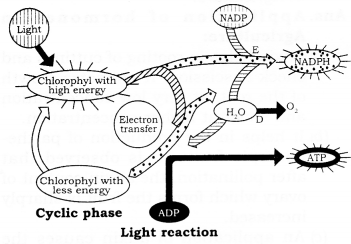
(B) Dark reaction or Blackmann reaction-
It is a light-independent process, in which reduction of CO, takes place. In reality, it is a biochemical process. Though it does not depend on light, energy and reducing agent synthesised in the last step are used in it. So, it is called dark reaction or biochemical reaction. The reactions of this step take place in the cavity of chloroplast called stroma. This step is called C3 or Calvin cycle because the first product contains 3 carbon atoms.
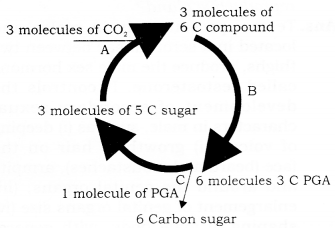
Assimilation of carbon takes place through the Calvin cycle. In this cycle, assimilation of carbon takes place in the form of 3 carbon atom compound viz. Phosphoglyceric acid (PGA). So, the cycle is called C3 and the plants in which this cycle is found are called C3 plants.
But in some plants, first fixed product in the cycle is made up of four carbon atoms called oxaloacetate. This cycle of reduction of carbon is called C4 cycle and the plants in which this cycle is found are called C4 plants.
Question 2.
Describe the factors affecting photosy¬nthesis.
Answer
Factors affecting photosynthesis:
(1) External Factors:
(1) Light: The main source of stored energy in the molecules of carbohydrate by photosynthesis is light. Leaves absorb 80 to 85% of the light falling on them. Only 0.5 to
3.5 % of absorbed light is used for photosynthesis. Rest is wasted in the form of heat or used in transpiration. Light affects the rate of photosynthesis indirectly. Low intensity of light causes stomatal closure, which restricts the entry of CO2 and photosynthetic rate decreases. High light intensity increases the rate of transpiration. This has an inhibitory effect on the rate of photosynthesis.
(2) Oxygen: Photosynthesis rate is reduced due to the increase in the concentration of oxygen in the intercellular space or in the environment.
(3) Carbon dioxide: The concentration of carbon dioxide in the environment is 0. 035% (350 ppm), which is often a limiting factor. When the concentration of carbon dioxide increases to 1%, the rate of photosynthesis also increases.
(4) Temperature: Light reaction is not affected by temperature. But dark reaction completely depends on temperature. The rate of photosynthesis is doubled with an increase of every 10°C between 5°C and
30° C.
(5) Water: Water is a compulsory factor for photosynthesis. Only 1% of water absorbed by plants is used for photosynthesis. However, the deficiency of water affects the rate of photosynthesis. The decrease of H2O content of leaves may cause complete closure of the stomatal opening. Another indirect effect of water deficiency is the accumulation of sugar in the cells which increases the rate of respiration and thus, decreases the rate of photosynthesis apparently.
(6) Air pollutants: Sulphur dioxide (SO2) and oxides of nitrogen decrease the rate of photosynthesis.
(2) Internal Factors:
- Chlorophyll contents: It is an important plastid, because it entraps light energy for photosynthesis.
- Protoplasmic factor: An unknown factor present in protoplasm affects photosynthesis, which is called the time factor.
- Accumulation of carbohydrates: If products of photosynthesis are not transported from leaves to other parts, these products begin to accumulate in photosynthetic cells. As a result of which, the rate of photosynthesis decreases.
Question 3.
How does the exchange of gases occur as a result of respiration in human beings?
Answer
The exchange of gases in a human being can be divided into two parts.
(1) Inspiration,
(2) Expiration. Inspiration is taking in air rich in oxygen and expiration is throwing out of the air, which is saturated with carbon dioxide.
(1) Inspiration: The muscles between the ribs pull them upwards and outwards. The muscular diaphragm also contracts and flattens, so the pleural cavity is expanded. With this expansion, the lungs also expand. As a result, the air pressure in lungs become low in comparision to the air pressure outside. Hence, an air pressure gradient is formed. As a result, air rushes through the nasal passage and reaches air sacs of the lungs.
(2) Expiration: With the relaxation of ribs and muscles of diaphragm chest box contracts and air of lungs goes out with pressure, through the nostrils. We must remember that we inhale and exhale air, due to alternate order of outer air pressure of the body and pressures is due to movement of chest muscles. In this action, the lungs do not participate.
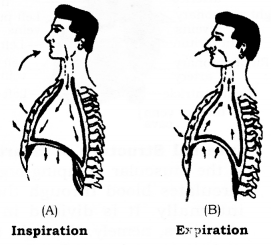
Question 4
Describe with the help of diagrams the internal and external structure of the heart.
Answer
External Structure of heart: Human heart is a four-chambered organ, with two auricles and two ventricles. It lies in the thoracic cavity, in between the two lungs. Its weight is about 300 gm. It remains enclosed in a double-walled membranous sac called pericardium. An interarterial and interventricular septum separate left and right side of the heart. Auricles are the upper chambers, and ventricles are lower chambers. Auricles are thin-walled and receive blood from four pulmonary veins and two vena- cava. Left auricle opens into the left ventricle, through an auricula- ventricular opening, guarded by a pair of flaps called the bicuspid valve. Similarly, tricuspid valve guards the aperture between the auricle and the ventricle. The left ventricle opens into the aorta, while the right ventricle opens into the pulmonary artery.
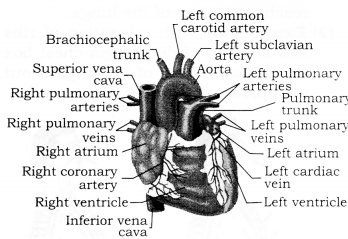
Internal Structure of Heart: Heart is the muscular pumping organ that circulates blood through the body, internally. It is divided into four chambers, namely, the right and left atria or auricles and right and left ventricles. The right and left sides of the heart are separated and do not
The upper chamber, the auricles or atria, are relatively thin-walled, receive blood from the veins. Oxygenated blood from the lungs enters the left atrium, the pulmonary veins and deoxygenated blood from the body enters the right atrium, from the vena- cava. The left atrium is connected to the left ventricle through a valve. Similarly, the right atrium is connected to the right ventricle, through another valve. These valves prevent the backflow of blood into atria when the ventricles contract to pump blood out of the heart to the rest of the body. All the atria and ventricles of the heart contract and relax at appropriate times and makes heart behave like a pump. A pericardium sheath protects the muscular heart. The chamber of the heart is separated by partition septum.
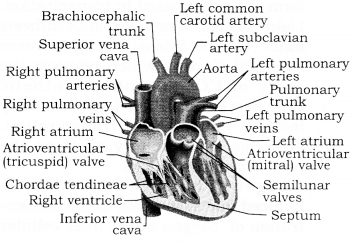
Question 5.
Explain Cohesion-transpiration theory.
Answer
The Cohesion-transpiration theory was given by Dixon and Jolly, in the year 1894. This hypothesis is based on three main facts.
(a) Cohesion between water molecules keeps the xylem vessel fully filled with water. The molecular force between water molecules is strong enough to hold together a column of water as high as 400 meters.
The capillary attraction between water and walls of vessels also helps to maintain the column of water
(b) Xylem vessels are so arranged that they are in continuity from root to leaves. So columnar continuity of water is maintained.
(c) Plants transpire water. It creates a reduced pressure in leaves. So, a suction pressure is exerted on the water column and the water column is drawn up because of suction, due to transpiration. The root pressure which draws in water from the soil also helps to keep the xylem filled with water. The suction due to transpiration is transmitted through a continuous column of water, from root tip to leaves and whole water column rises up. The pull or suction due to transpiration and rise of water column can be demonstrated by a simple experiment.
Experiment: Take a glass tube, about 25 cm long and 0.5 cm in diameter. Fill it with water. At its one end, fit a freshly cut twig, with the Water- help of cork and invert the lower end into mercury kept in a beaker. Make the apparatus airtight, Cohesion by applying a layer of transpiration vaseline on the cork. Keep the apparatus for some time. Mercury will rise in the tube. It shows that water present in the tube is being pulled upwards, by the transpiring shoot, as a result of transpiration pull.
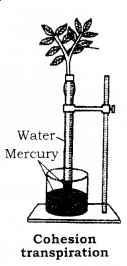
The twig loses water during transpiration. This causes reduced pressure in leaves and causes tension on the water column, due to suction. This tension is transmitted throughout the water column, which rises up and mercury in the tube rises to take its place.
Question 6.
Show experimentally that liquid food is conducted by phloem.
Answer
Take a well-watered potted plant and from a stem, above 6 inches from the surface of the soil, remove a girdle containing bark, cortex and phloem, leaving the only xylem. After some time, it will be observed that the growth of the plant below the girdle is reduced while above the girdle growth remains normal or even enhanced. Since xylem conducts water from roots to leaves, the potted plant will not wilt. The prepared dissolved food will not be able to cross the band portion since phloem have been scraped out.
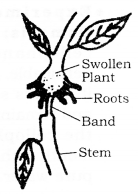
As a result, the food will go on collecting just above the band and it will swell up and may sprout roots. Growth will be reduced below the girdle. Thus, reduced growth below the girdle and swelling of the upper portion indicates that organic food material manufactured by leaves is unable to move below the girdle, because of the absence of phloem. This experiment shows that liquid food material in a plant is translocated through the phloem.
Question 7.
What is osmosis? Explain with the help of an experiment.
Answer
Osmosis may be thought of a special type of diffusion, which involves the movement of water or other solvent molecules through a semipermeable (or differentially permeable) membrane from an area of high potential (pure solvent) to an area of low potential (more concentrated solution). In a plant cell, the absorption of water or solution from an outside atmosphere, from cell to cell takes place through the plasma membrane, which is semipermeable. The semi-permeable membrane permits the passage of solvent but restricts the movement of most of the solute particles.
Experiment to demonstrate Osmosis: Taken a small bag of cellophane. Cellophane is semi-permeable. Filled 2% sugar solution in it. In this solution, there is 2% sugar and the remaining 98% is water. Suspend the cellophane bag after tying its mouth with thread, in a beaker having pure water.
The concentration of water in the beaker is 100% and the concentration of water filled up in the bag is 98%. So, water molecules will diffuse from a beaker into the bag, i.e., from high concentration to low concentration. On the other hand, the concentration of sugar in the bag is 2% and it is zero percent in the beaker. Thus, sugar molecules will diffuse into the beaker, but its rate will be slow.
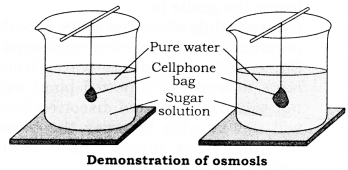
As a result of these, the bag will swell up because of more water coming in it. The bag will remain in the swollen position, because of the pressure generated by water filled in that bag. The diffusion of water and sugar molecules from higher concentration to lower concentration through a semi-permeable membrane is called osmosis and the pressure generated by osmosis is called osmotic pressure. Osmotic pressure helps to move water through conducting system in plants. It helps plant cells to retain water and keeping their shape and rigidity. Osmostic pressure operates the guard cells and thus, affects the opening and closing of stomata.
Question 8.
Explain the internal structure of the kidney?
Answer
The internal structure of the kidney: Kidney is divided into two parts. The outer part is called cortex and the inner part is called medulla.
(a) Nephrons: In medulla of each kidney, there are about one million coiled tiny tubules called nephrons. These are structural and functional units of the kidney. Each nephron is differentiated into two parts. Anterior part is called Malpighian capsule and remaining part is called tubule.
The outer part of Malphigian capsule is a cup-shaped, called Bowman’s capsule and a knot like a mass of blood capillaries situated in it, is called glomerulus. The capsule leads into a tubule. The beginning part is called proximal convoluted part.
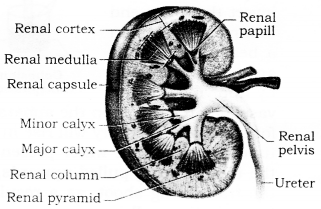
There is a U shaped thin loop of Henle, which is followed by the distal convoluted part. It opens into the main collecting tubule. It finally opens into funnel shaped pelvis of uthereter in the kidney.
(b) Ureter: A thin and muscular tube arises from each kidney. It is called ureter. It opens into the urinary bladder, by a hole. Both these ureters open into the urinary bladder. They bring urine from kidneys.
(c) Urinary bladder: It is a muscular bag in which urine is stored. It stores urine, temporarily.
(d) Urethra: It is a membranous tube, arising from the neck of the urinary bladder. By the contraction of muscles of the urinary bladder, the urine gets out of the body through the urethra.
Question 9.
What is excretion? How is urine excreted out by kidney?
Answer
Excretion: During cellular respiration various metabolic reactions occur in the body, leading to the formation of various waste products, such as carbon dioxide, urea. These waste products are harmful. Therefore, the removal of these waste products is a must. Thus, excretion is the process of removal of metabolic wastes from the body.
Formation of Urine: This is a physical reaction. Nephrons of the kidney are separate and independent units for the formation of urine.
- Three process occur in nephrons:
- Glomerulus ultra-filtration
- Selective re-absorption and
- Tubular excretion.
The blood enters the kidney by the renal artery. After entering the kidney, the renal artery is divided and sub-divided to form a network of blood capillaries. These capillaries form a dense network in the Bowman’s capsule, which is called glomerulus. The blood capillaries entering glomerulus are called afferent arterioles. The diameter of afferent arterioles entering the glomerulus is greater than efferent arterioles, resulting in the increase of blood pressure in the glomerulus. Due to this pressure, the excess of water, urea, glucose uric acid and some salts pass from blood to the Bowman’s capsule. This is glomerulus ultrafiltration. When this filterate passes through the glandular part, glucose, useful salts and some part of water are re-absorbed. This is re-absorption. The liquid left after reabsorption is now called urine. This urine then passes through the ureter into the urinary bladder.
Urinary bladder has involuntary muscles. As soon as the urinary bladder fills up, the involuntary muscles contract and urine are expelled out of the body through the urethra.
Question 10.
Draw the diagram of the excretory system of human?
Answer
Following are excretory organs in the human body.
- Kidney – one pair.
- Ureters – One pair
- Urinary bladder – One
- Urethra – One
In addition to above other excretory organs, other organs are skin, liver, spleen, intestines and lungs which help in excretion.
(a) Kidney: Kidneys are the principal organs of the excretory system. They are bean-shaped and lie on either side of the vertebral column of the abdominal cavity. Kidneys are two in number, dark red in colour and about 10 cm long, 5 cm broad 4 cm thick. On the inner side, there is a depression, through which the ureter runs out to the urinary bladder.
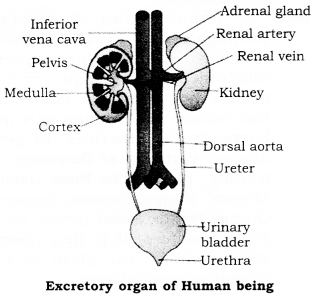
Other excretory organs:
1. Skin: There are numerous small pores on our opening of sweat ducts. The excess of salt and urea along with water diffuse into the sweat glands and escape through the opening of the sweat duct, in the form of perspiration.
2. Liver: Liver converts ammonia into urea. Afterwards, this urea is sent to kidney through blood. Urea is filtered from kidney and discharged in the form of urine.
3. Spleen: The cells of spleen and liver destroy the damaged red blood corpuscles. They make bile pigment from respiratory pigment, which is poured in small intestines along with bile.
4. Intestine: Though intestine does not take an active part in excretion, waste product along with bile juice secreted by the liver and other waste products such as carbonates and phosphates are discharged.
5. Lungs: Carbon dioxide is formed due to oxidation of various food stuff. Blood brings carbon dioxide from different parts of the body to the lungs. This carbon dioxide goes out through nostrils.
Question 11.
Explain the different methods of artificial vegetative reproduction in plants. Write the importance of vegetative reproduction?
Answer
The phenomenon of vegetative propagation is fairly common in a number of plants. This property of multiplication through vegetative organs has proved a boon and it has become an essential part in the horticultural practices, in getting desired varieties of flowering and fruiting plants (like Rose, Jasmine, Mogara, Mango, Banana, Sugarcane Orange Potato, Sweet potato, etc.) In such practices, it is first observed which part of the plant helps in j vegetative reproduction.
There are four methods of artificial vegetative propagation:
(a) Cutting: Many plants like rose, sugarcane, croton, coleus, etc., may be easily grown from stem cuttings. The cuttings of the stem of such plants are planted obliquely in moist fertile soil, in such a way that their two-third part remains in the soil. Roots growing from the cut end kept in the soil, while the buds at the node develop into the auxiliary shoot and thus, a new plant is developed.
(b) Budding: In this method, a bud of superior variety is forced to unite with the shoot of an ordinary variety of the same species. In this way, a plant of ordinary variety develop into a superior variety. This method has been successfully employed to propagate varieties of the plants of ornamental and economic value.
(c) Grafting: In this process, a shoot of a superior variety called scion or graft, is forced to unite with an ordinary variety, called stock. Many varieties of the fruit trees like mango orange, seedless grapes and guava are developed by this method.
(d) Layering: This method is commercially practised in plants having flexible soft branches. This method is commercially followed in growing Jasmine, Mogara, Magnolia etc.
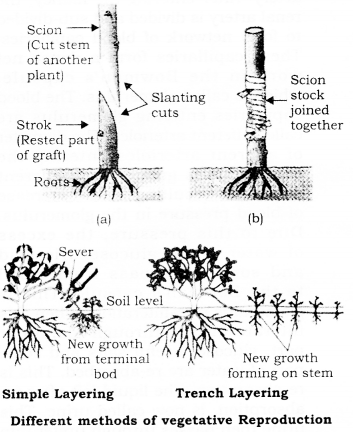
Importance of Vegetative Propagation:
(a) In some seedless varieties of plant-like Banana, Grape, Orange, etc., it is the only method of propagating the varieties of plants.
(b) In propagating plants through seeds there is always a danger that seeds may have dormancy, they lose their viability and all the seeds may not germinate. In such a case vegetative propagation is a blessing for farmers and gardeners.
(c) The development of plants is very slow when propagated through seeds, while through vegetative propagation, it is comparatively much faster.
(d) Vegetative propagation in plants shows a higher rate of production.
(e) The varieties of plants propagated by vegetative reproduction retain the character of the mother plant, while those propagated through seeds do not come true. This is the reason, to retain desirable characters all fruits trees are propagated by vegetative means.
Question 12.
Describe asexual reproduction in lower groups of animals.
Answer
Asexual reproduction: All the organisms start their life from a single cell. If this cell is given by only one parent, it is called asexual reproduction.
The main methods of asexual reproduction are as follows:
(1) Budding: In this method, an outgrowth | called bud is formed on the body of the animal. It grows in size and j separates from the parent body and develops into a new animal.
Example: Hydra, Vorticella.
(2) Binary fission: In this method, the parent animal gets divided into two similar animals. It is a complex process of mitotic division.
Example: Amoeba, Euglena, Paramecium.
(3) Multiple fission: In this type of fission, first the nucleus divides the number of times to form many daughter nuclei. After this division, in cytoplasm cytoplasts collect around all the daughter nucleus. In this way, many individuals are produced. This type of reproduction takes place under unfavourable conditions and a thick cyst is formed. On the return of favourable conditions, the cyst breaks and the young organism come outside, e.g. Amoeba.
(d) Schizogony: In this method, the parent nucleus divides to give rise to many daughter nuclei. The cytoplasm also divides and many nucleated cytoplasmic units are formed, which develop into a new organism, e.g., Plasmodium.
Question 13.
Describe the structure of the nerve cell with the help of a diagram. How does the conduction of nerve impulse take place? Explain.
Answer
Among mammal, the human nervous system is the most developed and complex. The brain acts as the main coordinator. There is a network of nerve cells in the entire body. The structural and functional unit of the nervous system is the nerve cell. The brain and network of nerves are called nervous system. The nerve cell is the longest cell of the body. The nerve cell has three parts- soma, dendrites and axon. The soma is like a simple cell. It has a nucleus and various cell organelles. The soma has nissel granules. It lacks vacuoles The dendrites are small and branched. They receive impulses and conduct them towards soma. Axon is a slender and fibre like an extension. It conducts the nerve impulses away from the soma. The terminal part of an axon of the nerve cell is found in contact with the dendrites of another nerve cell. This functional junction of two nerve cells is called synapsis.
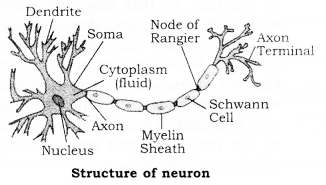
Conduction of impulse: The sensory nerves carry the impulses to the controlling centre(brain or spinal cord). In the controlling centre, the impulses are analysed and its responses are decided. The motor nerve carry the responses, in the form of impulses to the organ, where its reaction is to take place. This process is called response to a particular stimulus. The membrane covering the neuron is electrically charged. The positive charge (+) is on the outer surface, while the negative charge (-) is on the inner surface.
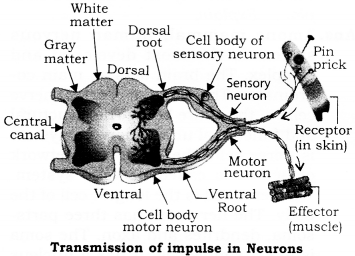
These two charges are unequal, hence there is a potential difference in the two surfaces of the membrane. As soon as the stimulus is received by the dendrites, the positively charged ions begin to move inside and the negatively charged ions begin to move outside. This causes an impulse and depolarisation stage is created. After passing the impulse, polarisation stage is restored. As the impulses move forward again, depolarisation stage is reached. In this way, the process of polarisation and depolarisation continues and the impulse moves forward. When the impulse reaches the end of the axon, three hormones- adrenaline, acetylcholine, serotonin are secreted. These help in passing of the impulse from one neuron to another, at the synapse.
Question 14.
Describe with the help of a diagram, the structure of the human nervous system and functions of the brain?
Answer
The nervous system of man consists of two parts:
(a) The central nervous system.
(b) The peripheral nervous system.
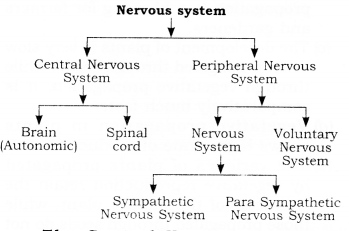
(a) The Central Nervous System: It consists of the brain and spinal cord. It is responsible for the coordination and control of the activity of the nervous system. CNS enables a person to give a more appropriate and more intelligent response to various situations. The work of the central nervous system is to collect all the information from all the receptors in our body. In complicated responses the brain and spinal cord, both are involved.
1. Brain: Human brain is shaped like a large mushroom. It is located in the bony cavity of the skull, called cranium. The brain is covered by three membranes, called meninges. The fluid (cerebrospinal) is filled between these membranes. This fluid protects the brain from mechanical shocks.
The brain is divided into three regions:
(a) Forebrain,
(b) Midbrain,
(c) Hindbrain.
The forebrain is the largest region, covering 2/3 portion of the brain. It mainly consists of the cerebrum.
Midbrain is quite small and inconspicuous. It connects cerebrum to the other parts of the brain and spinal cord.
Hindbrain consists of three main parts
(a) medulla oblongata,
(b) pons and
(c) cerebellum.
2. Spinal cord: It consists of a number of nerve cells, both fibres and cell bodies, grouped into a cylindrical mass that extends from the brain to the bottom edge of the first lumbar vertebra. It is covered by the same meninges as the brain and lies within the neural canal of the vertebral column. A cross section of the spinal cord reveals an outer region of white matter and an inner H-shaped region of grey matter. The grey matter consists of cell bodies of thousands of neurons.
The white matter is composed of myelinated nerve fibres, running up and down the cord or passing out to the spinal nerves. Running through the centre of the spinal cord is the central canal. Dorsal and ventral fissures (grooves), divides spinal cord into right and left halves. The spinal cord has two-fold
functions: It conducts impulses to and from the brain and acts as a reflex centre.
(b) Peripheral nervous system:
This consists of three parts: Cranial nerves; Spinal nerves and Autonomic nervous system.
Cranial nerves: The cranial nerves are those that emerge from the brain e.g. in man, there are twelve pairs of cranial nerves, which are mainly supplied by the organs in the head region.
Spinal nerves: These are supplied by the spinal cord. There are 31 pairs of spinal nerves, all of which are mixed nerves. These include 8 cervical, 12 thoracic, 5 lumbar, 5 sacral and 1 coccygeal.
Autonomic nervous system: This lies outside a.nd parallel to the central nervous system and is organised into two distinct regions, sympathetic system and parasympathetic system. While the former consists of thoracic and lumbar ganglia and using only spinal nerves, the latter uses three spinal nerves of the lower region of the cord, i.e., sacral part and four cranial nerves. The autonomic nervous system consists of two sets of nerves with opposite actions- If one speeds up activity, the other decreases it. The autonomic nervous system controls the functions of the internal organs of the body automatically and unconsciously.
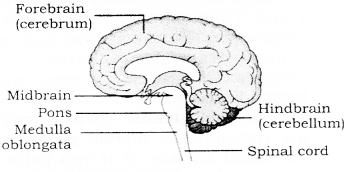
It sends impulses via the efferent or motor neurons to the effector structures, other than the skeletal muscles. These structures include smooth muscles, lining the wall of digestive, respiratory, urinary and reproductive tracts; the smooth muscles of blood vessels and eye, the cardiac muscles of heart and both, exocrine and endocrine glands. Thus, the autonomic nervous system regulates
- the contraction of the involuntary muscle,
- the rate and force of the heartbeat,
- the secretion of the glands of the alimentary tract, and
- the size of the pupil of the eye.
Functions of Brain:
- The brain receives impulses from all sensory organs, such as eyes, ear, etc.
- After receiving signals or impulses from sensory organs, the brain sends off instructions to muscles and glands, to respond through motor neurons.
- Brain correlates various stimuli from different sense organs.
- Brain efficiently coordinates the activities of our body.
- Brain stores information, in the form of our knowledge.
- The brain is responsible for thinking and intelligence.
Question 15.
Describe any four endocrine glands j and explain the effects of hormones secreted by them.
Answer
The four endocrine glands are:
1. Pineal gland,
2. Thymus gland,
3. Parathyroid gland,
4. Adrenal gland.
1. Pineal gland: This gland is situated on the mid-dorsal surface of posterior part of the anterior brain. It is poly-lobed. It is somewhat flattened and round | structure. It secretes melatonin hormone which I inhibit ovarian growth and ovulation. It controls and regulates menstrual cycle, activity and development of gonads.
2. Thymus gland: Thymus gland is located just above the heart and under the chest bone. It develops from birth to youth and afterwards, its size begins to decrease.
The gland secretes thymosin. Thymosin I and Thymosin II. It produces lymphocytes. These hormones inspire lymphocytes to destroy germs and antigens. Thus, these hormones are helpful in the security system of the body.
3. Parathyroid glands: These glands are embedded in thyroid gland on its dorsal surface. It is two pairs,
4 in number. Its hormone is called parathormone. This hormone controls the number of calcium and phosphate ions. It also controls the development of bones and formation of teeth. Deficiency of parathormone hormone causes contraction of muscles, for a long time. This disease is called tetany.
Oversecretion of parathormone rot the bones, so the bones become slender, weak and brittle. This condition is called osteoporosis.
Adrenal gland: Adrenal gland is present on the upper end of each kidney, fitting like a cap. It is also called supra-renal gland. The gland consists of two regions-the outer is called cortex and the inner one is called medulla.
Cortex:
The cortex secretes three hormones (C-orticoids).
- Mineralocorticoid,
- Glucocorticoid
- Gonadocorticoid
1. Mineralocorticoid: This hormone regulates the balance between sodium and potassium ions in the blood. If this hormone becomes deficient, more sodium is excreted through the urine and cardiac output is reduced. This can even cause death. This hormone is thus, known as “the life-saving hormone”.
2. Glucocorticoid: This is concerned with carbohydrate metabolism and hence, called glucocorticoid. This hormone creates the ability in the body to resist diseases. This hormone controls energy formation and protein synthesis, in the body.
3. Gonadocorticoid: The cortex of the adrenal gland secretes the male hormone, androgen and also a female hormone. Both are called gonadocorticoid hormones. Any imbalance in the amounts of these hormones, might lead to a change of sex also. In women, if more androgen is secreted, male characteristics start appearing i.e. moustaches appear.
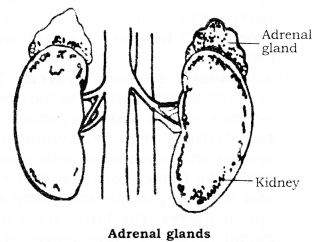
We hope the given RBSE Solutions for Class 9 Science Chapter 8 Major Activities of Living Organisms will help you. If you have any query regarding Rajasthan Board RBSE Class 9 Science Chapter 8 Major Activities of Living Organisms, drop a comment below and we will get back to you at the earliest.
Try Once: